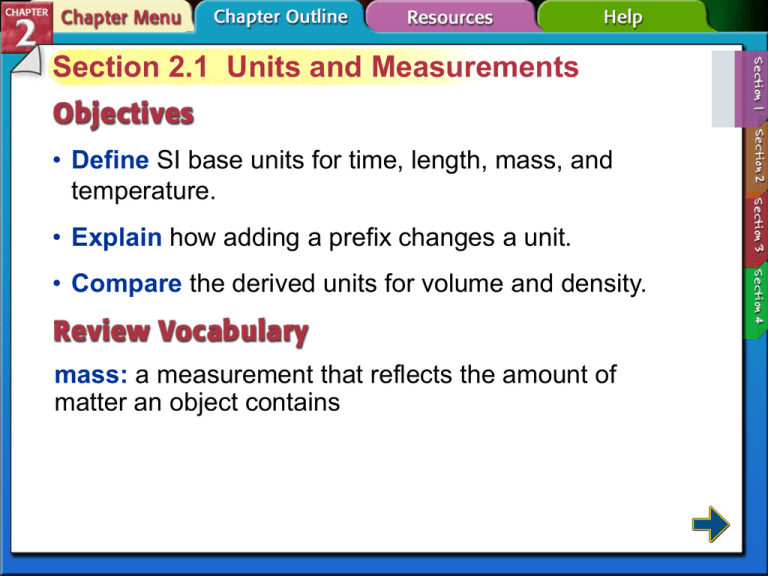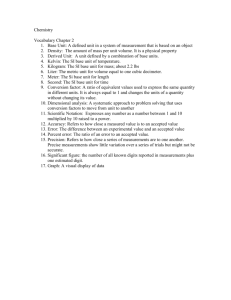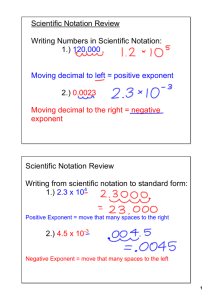Derived Units
advertisement

Section 2.1 Units and Measurements • Define SI base units for time, length, mass, and temperature. • Explain how adding a prefix changes a unit. • Compare the derived units for volume and density. mass: a measurement that reflects the amount of matter an object contains Section 2.1 Units and Measurements base unit kelvin second derived unit meter liter kilogram density Chemists use an internationally recognized system of units to communicate their findings. (cont.) Units • Système Internationale d'Unités (SI) is an internationally agreed upon system of measurements. • A base unit is a defined unit in a system of measurement that is based on an object or event in the physical world, and is independent of other units. There are seven base units in SI. All other units are derived from a combination of these base units. Units (cont.) Table on p. 33 of your textbook Units (cont.) Table on p. 33 of your textbook Prefix Symbol Numerical value in base units Power of 10 equivalent Giga G 1,000,000,000 109 Mega M 1,000,000 106 Kilo K 1000 103 Hecto h 100 102 Deka da 10 101 --- ---- 1 (base) 100 Deci d 0.1 10-1 Centi c 0.01 10-2 Milli m 0.001 10-3 Micro μ 0.000001 10-6 Nano N 0.000000001 10-9 Pico P 0.000000000001 10-12 Units (cont.) • The SI base unit of time is the second (s), based on the frequency of radiation (the time for a large number of vibrations) given off by a cesium-133 atom. • The SI base unit for length is the meter (m), the distance light travels in a vacuum in 1/299,792,458th of a second. • The SI base unit of mass is the kilogram (kg). This weighs about 2.2 pounds. The kilogram is an actual physical standard of platinum and iridium. Scientists are working to redefine this. Mass and weight are two different things. • Because the kilogram is a large unit of measure, in the lab we will usually measure grams. • How many milligrams are in a gram? Mass is a measure of how much “stuff” there is….the amount of matter in an object. If you go to the moon, your weight changes, but your mass does not. Units (cont.) • The SI base unit of temperature is the kelvin (K). • Zero kelvin is the point where there is virtually no particle motion or kinetic energy, also known as absolute zero. • You may be more familiar with the Celsius scale. This scale was set up based on the boiling and freezing of water. On this scale, water freezes at 0°C and boils at 100°C. In lab, we will measure Celsius degrees. To convert from Celsius to Kelvin, the formula is: K = °C + 273 Example: Water boils at 100 °C. What temperature is that on the Kelvin scale? Example 2: A metal has a temperature of 423 K. What temperature is that in degrees Celsius? • Two other temperature scales are Celsius and Fahrenheit. • To convert from Celsius to Fahrenheit, the formula is: °F = 1.8(°C) + 32 Example 3: If the temperature outside is 25 °C, what temperature is that in Fahrenheit? Derived Units • Not all quantities can be measured with SI base units. • A unit that is defined by a combination of base units is called a derived unit. • For example, the standard unit for speed in the metric system is m/s. This unit is derived by dividing the SI unit for length (meter) by the SI unit for time (second). Derived Units (cont.) • Volume is measured in cubic meters (m3), but this is very large. A more convenient measure is the liter, or one cubic decimeter (dm3). Derived Units (cont.) • Density is a derived unit, g/cm3, the amount of mass per unit volume. m • The density equation is D= density = mass/volume. v • Example: Find the density of a metal box that has a volume of 5 cm3 and a mass of 44.6 grams. • From page 971, what type of box is it? Section 2.1 Assessment Which of the following is a derived unit? A. yard B. second C. liter D C A 0% B D. kilogram A. A B. B C. C 0% 0% 0% D. D Section 2.1 Assessment What is the relationship between mass and volume called? A. density B. space D A 0% C D. weight A. A B. B C. C 0% 0% 0% D. D B C. matter Section 2.2 Scientific Notation and Dimensional Analysis • Express numbers in scientific notation. • Convert between units using dimensional analysis. quantitative data: numerical information describing how much, how little, how big, how tall, how fast, and so on Section 2.2 Scientific Notation and Dimensional Analysis (cont.) scientific notation dimensional analysis conversion factor Scientists often express numbers in scientific notation and solve problems using dimensional analysis. Scientific Notation • Scientific notation can be used to express any number as a number between 1 and 10 (the coefficient) multiplied by 10 raised to a power (the exponent). • Count the number of places the decimal point must be moved to give a coefficient between 1 and 10. Scientific Notation (cont.) • The number of places moved equals the value of the exponent. • The exponent is positive when the decimal moves to the left and negative when the decimal moves to the right. 800 = 8.0 102 0.0000343 = 3.43 10–5 Example: Express 123 456 in scientific notation. Scientific Notation (cont.) • Addition and subtraction – Exponents must be the same. – Rewrite values with the same exponent. – Add or subtract coefficients. Examples: Add 1.23 x 103 and 2.46 x 103 Add 2.2 x 102 and 3.33 x 103 (or…use your calculator!) Scientific Notation (cont.) • Multiplication and division – To multiply, multiply the coefficients, then add the exponents. – To divide, divide the coefficients, then subtract the exponent of the divisor from the exponent of the dividend. Dimensional Analysis • Dimensional analysis is a systematic approach to problem solving that uses conversion factors to move, or convert, from one unit to another. • A conversion factor is a ratio of equivalent values having different units. Dimensional Analysis (cont.) • Writing conversion factors – Conversion factors are derived from equality relationships, such as 1 dozen eggs = 12 eggs. – Percentages can also be used as conversion factors. They relate the number of parts of one component to 100 total parts. Dimensional Analysis (cont.) • Using conversion factors – A conversion factor must cancel one unit and introduce a new one. This is an example that shows how to use conversion factors in finding how many 8 packs of soda you would need for a party of 32 people, assuming each person drinks 2 bottles of soda. • Examples: Use conversion factors to make the following conversions: • 240 s to ms. • 46 kg to Mg. Section 2.2 Assessment What is a systematic approach to problem solving that converts from one unit to another? A. conversion ratio A 0% D D. dimensional analysis C C. scientific notation A. A B. B C. C 0% 0% 0% D. D B B. conversion factor Section 2.2 Assessment Which of the following expresses 9,640,000 in the correct scientific notation? A. 9.64 104 A 0% D D. 9.64 610 C C. 9.64 × 106 A. A B. B C. C 0% 0% 0% D. D B B. 9.64 105






